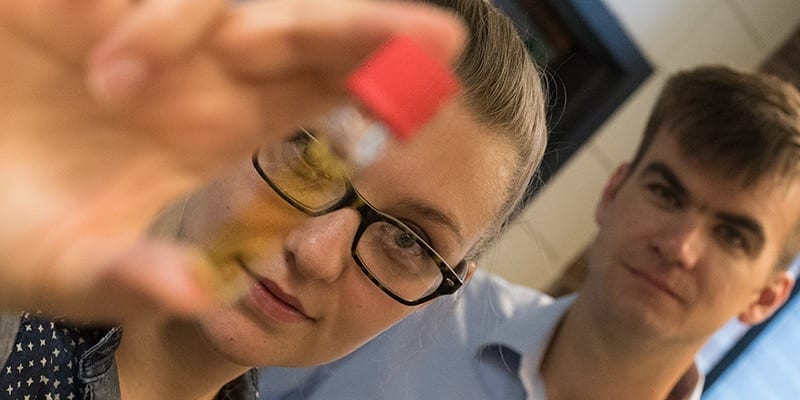
A rule of chemistry suppressed — promising new ways to look into cells, make LEDs
Glow-in-the-dark stickers, weird deep-sea fish, LED lightbulbs — all have forms of luminescence. In other words, instead of just reflecting light, they make their own.
Now a team of scientists from the University of Vermont and Dartmouth College have discovered a new way that some molecules can make a luminescent glow — a strange, bright green.
“It’s a new method to create light,” says Matthew Liptak, achemist at UVM who co-led the new research. The new light may have many promising applications including novel kinds of LED bulbs and medical dyes “that can sense viscosity within a cell,” he says.
The discovery was reported Sept. 26 in the journal Nature Chemistry.
New view
To understand how this new light is formed, consider maple syrup. It’s a thick liquid. The scientists at Dartmouth, led by chemist Ivan Aprahamian, were exploring some strange molecules, called molecular rotors, shaped like kayak paddles where both blades rotate around a shaft. (Yes, a very small shaft, many thousands of times thinner than a hair). In a thin liquid, like water, clumps of these rotating molecules — a kind of dye containing boron — give off a weak, reddish luminescent glow.
But when the scientists put the molecules into thicker and thicker maple-syrup-like solvents — in this case, mixtures of glycerol and ethylene glycol — the fluorescent light from these molecular rotors didn’t get weaker as expected. Instead, they glow brightly, in a vivid green color nearer the blue end of the spectrum.
“That was very surprising,” says Liptak, an expert on computational chemistry. So the Dartmouth team turned to him and his students to explain why. As the UVM team investigated, making simulations on the Vermont Advanced Computing Core— and both teams further investigated the molecules using spectroscopy and other lab techniques — they came to an even-more-surprising discovery: the way this light was being emitted required breaking a long-standing law of chemistry called Kasha’s Rule.
“We found a new way that the universe works that we didn’t understand before,” Liptak says. “It’s an exception to the rule.”
The world has color because molecules absorb and give off light according to the “spooky” rules of quantum mechanics. In most cases, a molecule will absorb a specific wavelength of light and we will see its complement on the color wheel. In some cases, molecules “glow in the dark” by emitting a specific color of light a short time after absorbing light. This is luminescence.
In 1950, the famed chemist Michael Kasha observed that a luminescent molecule generally emits the same color light regardless of the color of light that it initially absorbed. This is because the first step following absorption of light is a molecular relaxation — a rapid vibration, stretching and release of heat — to get the molecule to its “lowest energy excited state,” Liptak explains. So when a typical luminescent molecule absorbs higher energy light, towards the blue end of the spectrum, it simply produces more heat, not brighter or different-colored luminescence. “This is Kasha’s rule,” Liptak says.
More light
But the UVM/Dartmouth team, with support from the National Science Foundation, found that when their special rotor molecules are in a thick solution, their capacity to vibrate is limited and so they emit light before they are done vibrating. This is because the paddle-shaped part of the rotor must rotate freely in order to turn on the chemical pathway that allows it to give off heat energy — but this rotation is suppressed in a thick solution. The thicker the solution, the less the molecular paddles rotate, the more light can be emitted. Which is why the team is calling their discovery Suppression of Kasha’s Rule, or SOKR (pronounced “soccer”) for short.
“One way to understand SOKR is to think about a water slide with two outlets where one outlet is located far above the pool and the other is located at the level of the pool,” explains Liptak. “In low viscosity solutions like water, the paddles rush all the way to the bottom outlet and enter the pool without a splash. In high viscosity solutions like maple syrup, the paddles are slowed down, allowing some to spill out the top outlet creating a waterfall or, in the case of light-emitting molecular rotors, bright green light.”
Useful light
This new pathway to creating light may prove useful. “The compound we found is very bright, and due to its viscosity sensitivity, may have a multitude of applications,” says Morgan Cousins, a UVM doctoral student and co-author on the new study. “We see uses for these kinds of molecules from industrial materials to new kinds of LEDs to biomedical imaging.”
Consider cells. The many parts within a cell — from the endoplasmic reticulum to mitochondria — have different functions, and, presumably, have different viscosities too. But not much is known about this — which is where these fluorescent rotor molecules might help. The newly discovered molecules are not safe for use in a human, but the team is currently hunting for similar “bio-compatible” compounds, Liptak says, that could be incorporated into a medical dye or other test where they would glow brightly in more-viscous parts of a cell and less in more-watery parts. The molecules could be applied as a sensitive diagnostic tool because they precisely change the amount of light they emit based on the thickness of the solution they are in.
“Viscosity is a fundamental property of biological systems that we’re currently mostly blind to,” Liptak says. But this new discovery may shine new light.
Learn more: Discovery: A New Form of Light
The Latest on: Suppression of Kasha’s Rule
[google_news title=”” keyword=”Suppression of Kasha’s Rule” num_posts=”10″ blurb_length=”0″ show_thumb=”left”]
via Google News
The Latest on: Suppression of Kasha’s Rule
- Lionel Messi is no fan of new MLS rule: Why his outspoken opposition may spark adjustmenton May 14, 2024 at 4:06 am
Lionel Messi’s disgust for Major League Soccer's new injury rule is one thing. How he openly criticized the rule is quite eye-opening. Messi waited impatiently on the sidelines, eager to return ...
- Understanding the Rule of 72: A Key to Investment Growthon May 13, 2024 at 5:00 pm
With the Rule of 72, it's as easy as plugging numbers into a simple formula to determine how long your investment will take to double. Here's what you need to know about how it works and why it's ...
- How Much Should You Spend in Retirement? Use the 4% Ruleon May 11, 2024 at 10:50 am
The so-called 4% rule has only been around for a few decades, but it’s become a rule of thumb for financial advisors and investors looking for guidance on estimated yearly income withdrawals in ...
- Minority Rule review: rich history of America’s undemocratic democracyon May 5, 2024 at 9:44 am
to Republican voter suppression, Ari Berman covers it all Ari Berman’s new book is a rich history of America’s ambivalent attitude toward majority rule. The founding document declared “all m ...
- Breaking Kasha's ruleon April 29, 2024 at 2:27 pm
The emission of visible light from a dye encapsulated within a carbon nanotube gives great hope and new opportunities for the design of nanoscale optoelectronic devices. The physical principle of ...
- Washington State Court Ruleson April 26, 2024 at 12:16 pm
Please use this new link to preview the new redesigned Court Rules web site. In October 2019, the Administrative Office of the Courts, with the assistance of the Reporter of Decisions office and web ...
- Brutal suppression of a nation’s conscienceon April 24, 2024 at 5:00 pm
What Washington asked Sri Lanka not to do in the name of democracy, during Aragalaya in 2022, is being done in the US! There have been police crackdowns on US university students engaged in protests ...
- Jim Cramer's Investing Rule 6: Do Your Stock Homeworkon April 23, 2024 at 5:00 pm
So watch Rule #6 of his 25 Investing Rules to get your homework assignments now! Action Alerts Plus portfolio manager and TheStreet's founder Jim Cramer has learned a lot over his 30+ years of ...
- The GOP’s Grand Plan: Minority Ruleon April 23, 2024 at 5:00 pm
In the first issue of this newsletter, I wrote that Republicans were pushing for “political apartheid”—that is, minority rule ... tactics—like voter suppression and gerrymandering ...
via Bing News










